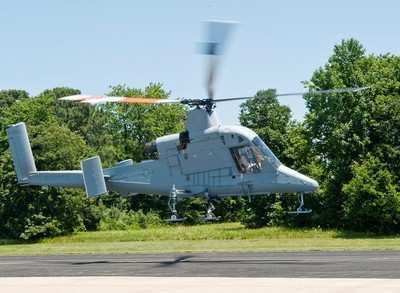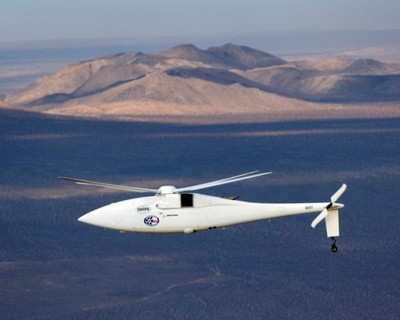Mon, Jul 11, 2011
One Of Two Systems To Deploy To Afghanistan Later This
Year
The Navy and Marine Corps' plans to field a cargo unmanned
aircraft system are moving forward as the first of two potential
UAS helicopters landed at NAS Patuxent River (Pax River) in
Maryland July 1. The Navy and Marine Corps Multi-Mission Tactical
Unmanned Air Systems program office (PMA-266) coordinated the
arrival of Lockheed Martin's KMAX helicopter, one of the systems
that will potentially deploy to Afghanistan later this year. "Our
team has worked very hard to respond to an urgent needs requirement
for a Cargo UAS capability in support of Marine Corps forces
engaged in Operation Enduring Freedom," said Capt. Patrick Smith,
program manager for PMA-266.

K-MAX UAS
In December 2010, PMA-266 awarded contracts to two suppliers,
Lockheed Martin and Boeing/Frontier Aviation, for potential
deployment support in Afghanistan. In order to meet the urgent
operational needs of the Marine Corps, both suppliers were selected
to reduce potential deployment delays and possible inability to
meet performance requirements. The Navy plans to deploy one of the
systems that has demonstrated ability to meet technical
requirements following a favorable Quick Reaction Assessment (QRA).
The second system may be used for future operational missions
and/or science and technology development.
The Lockheed Martin KMAX will begin Electromagnetic
Environmental Effects (E3) testing at the Pax River facility. The
purpose of E3 testing is to measure and provide results regarding
the aircraft's electromagnetic susceptibility to certain
frequencies, which can affect flight-critical and other systems
within the aircraft. The Boeing/Frontier Aviation Hummingbird will
go through the same testing at a later date. "Both the KMAX and
Boeing A-160T "Hummingbird" are required to go through E3 testing
prior to the QRA," said Eric Pratson, integrated product team lead
for the Cargo UAS program. "This will help insure that the aircraft
operates as designed while being exposed to ambient electrical
signals in Afghanistan."

Boeing Hummingbird
After completing E3 testing, two KMAX
UAS will be shipped to Yuma Proving Ground in Arizona in
preparation for QRA planned for August 2011. Under the guidance of
Commander Operational Test and Evaluation Force, Marines from
Unmanned Aerial Vehicle Squadron (VMU) 1 will act as operational
commanders and forward operating base controllers for a seven day
period. During that time, the system is required to deliver 6,000
pounds of slung load cargo per day. "A successful QRA will prove
sustainment of a cargo-carrying capability in an operational
environment," Pratson said.
The Navy's Cargo UAS service will augment Marine Corps ground
and air logistics operations in Operation Enduring Freedom. This
capability will also supplement rotary wing assets and reduce
Marine Corps exposure to Improvised Explosive Devices in theater.
The Navy intends to field Cargo UAS in fall 2011 for a six-month
deployment.
"Fielding this system will enable us to keep trucks off the road
and keep our troops safe," Smith added.
More News
Aero Linx: Model Aeronautical Association of Australia MAAA clubs are about fun flying, camaraderie and community. For over 75 years, the MAAA has been Australia’s largest fl>[...]
Touchdown Zone Lighting Two rows of transverse light bars located symmetrically about the runway centerline normally at 100 foot intervals. The basic system extends 3,000 feet alon>[...]
“Discovery and innovation are central to our mission at Virgin Galactic. We’re excited to build on our successful record of facilitating scientific experiments in subor>[...]
How To Get A Story On Aero-TV News/Feature Programming How do I submit a story idea or lead to Aero-TV? If you would like to submit a story idea or lead, please contact Jim Campbel>[...]
Student Pilot Reported That During Rotation, “All Of A Sudden The Back Of The Plane Kicked To The Right..." Analysis: The student pilot reported that during rotation, “>[...]
 ANN's Daily Aero-Linx (05.02.24)
ANN's Daily Aero-Linx (05.02.24) ANN's Daily Aero-Term (05.02.24): Touchdown Zone Lighting
ANN's Daily Aero-Term (05.02.24): Touchdown Zone Lighting Aero-News: Quote of the Day (05.02.24)
Aero-News: Quote of the Day (05.02.24) ANN FAQ: Contributing To Aero-TV
ANN FAQ: Contributing To Aero-TV NTSB Final Report: Cirrus Design Corp SR20
NTSB Final Report: Cirrus Design Corp SR20




